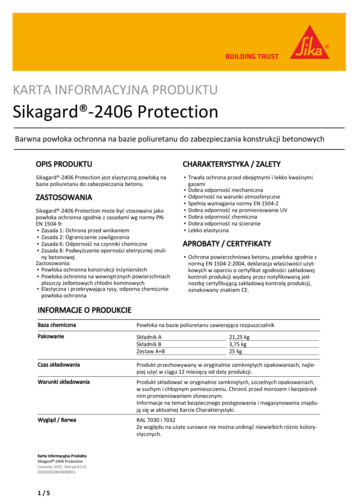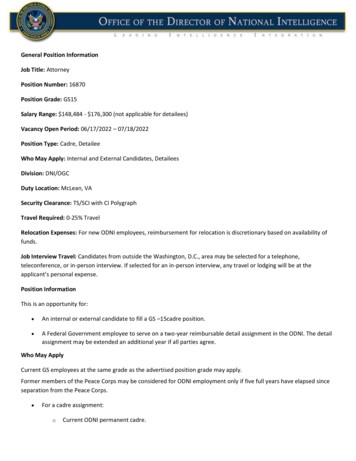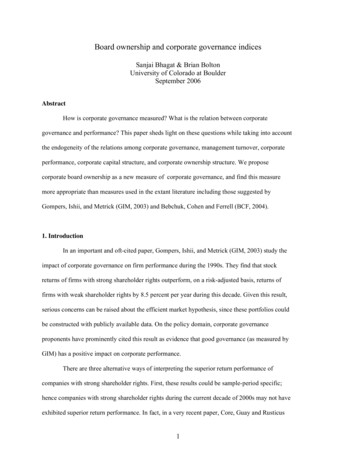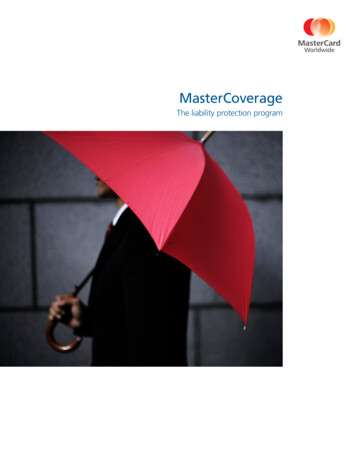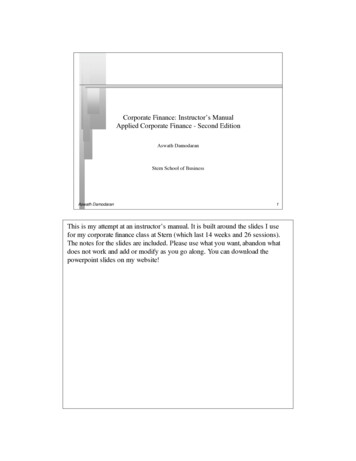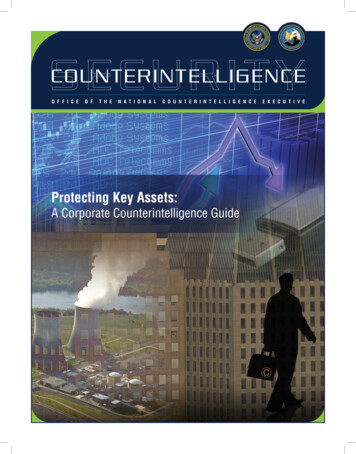
Transcription
COUNTERINTELLIGENCEO F F I C EO FT H EN A T I O N A LC O U N T E R I N T E L L I G E N C EProtecting Key Assets:A Corporate Counterintelligence GuideE X E C U T I V E
Counterintelligence for the Private SectorIntroduction.1Where the Money Is.2When Security is Not Enough. .3Step One: Conducting a Counterintelligence Risk Assessment.3A. Identifying and Prioritizing Assets.4B. Determining Threats. .4C. Assessing Vulnerabilities. .4Step Two: Laying the Groundwork for a Corporate CI Program. .5Step Three: Identifying the Capabilities Needed.6Step Four: Implementing a Corporate CI Program.7Program Management.7Staffing.9Maintaining an Effective Corporate CI Program. .10
IntroductionA disturbing trend has developed in which foreign intelligence services, non-state actors, and criminals areusing intelligence collection techniques against American companies to steal valuable trade secrets and assets.This activity can bankrupt a company by compromising years of costly research and development, weaken theU.S. economy, and threaten national security. According to the FBI, the cost to U.S. industry is tens of billions ofdollars each year.Corporate boards and executive officers must understand the true threat their companies face. It is one thathas evolved beyond the stage where information security, as one example, can simply be delegated to thesecurity office or CIO - it requires full executive engagement. With the tools available to economic spies, theAmerican private sector is more vulnerable than ever.Not too long ago, traditional corporate espionage was dangerous. It required the corporate spy to betrayone’s coworkers, clandestinely collect company documents, load and mark dead drops, and operate underthe constant risk of exposure and arrest. Yet corporate espionage, like so many activities, has moved into therealm of cyberspace. In cyberspace, many American companies are left working in the modern equivalentof the Wild West, an unregulated frontier where the crown jewels of the corporation - trade secrets andintellectual property - are hijacked every day, often without the victim’s knowledge. In turn, America oftenfinds itself competing with the very developments and technologies our companies pioneered.Companies must have aggressive security programs to protect their intellectual property, trade secrets,business processes, strategic goals, and the integrity of their brands. This guide outlines the steps involved inbuilding a corporate counterintelligence (CI) program to complement your company’s security program andrespond to the intelligence collection techniques used by today’s spies. An effective CI program will ensurethat your company has identified its most vulnerable assets, understands the threats to those assets, hasdiscovered the vulnerabilities that might make your company susceptible to exploitation, and has taken theappropriate steps to mitigate risks.Unlike many of our most active competitors who engage in cyber espionage, the United States does not have acentralized industrial policy - nor should it. Our long-standing prosperity is a reflection of the free market. Thatplaces a large responsibility on the shoulders of American CEOs. The U.S. Government will share threat andwarning information to the full extent of the law, but to protect our economy and our position on the globalstage, much of our national security will have to move from the war room to the board room.“Sensitive US economic information and technology are targeted by the intelligenceservices, private sector companies, academic and research institutions, and citizens ofdozens of countries.”- ONCIX Report to Congress on Foreign Economic Collection andIndustrial EspionagePROTECTING KEY ASSETS: A CORPORATE COUNTERINTELLIGENCE GUIDE 1
PROTECTING KEY ASSETS: A CORPORATE COUNTERINTELLIGENCE GUIDE 2Where the money is:Transformation in Corporate Asset Values CreatesEconomic VulnerabilityThe U.S. economy has changed over the past 20 years. Intellectual capital rather than physical assets nowrepresent the bulk of a U.S. corporation’s value. Research by Ocean Tomo Intellectual Capital Equity that iscaptured in the chart below shows the transition from an economy of tangible assets (real estate, hardware,vehicles) to one in which intangible assets (patented technology, trade secrets, proprietary data, businessprocess and marketing plans) now represent 81 percent of the value associated with the S&P 500. This shifthas made corporate assets far more susceptible to espionage.Simon Hunt, Vice President and Chief Technology Officer of McAfee, said in a 2011 report titled “UndergroundEconomies” that: “Criminals understand that there is much greater value in selling a company’s proprietaryinformation to competitors and foreign governments . . . the cyber underground economy has shifted its focusto the theft of corporate intellectual capital.”Composition of the S&P 500Source: Ocean Tomo Intellectual Capital Equity.
When Security is Not EnoughWhen companies become targets of competitors, foreign intelligence services, and criminal elements, evenaggressive security programs may not be enough. A CI risk assessment (described later in this guide) can helpdetermine the threat of espionage activity against your company and the size and scope of the CI program orcapabilities that are needed to address this threat.Counterintelligence and security are distinct but complementary disciplines, and it is important fororganizations contemplating the establishment of a CI program to understand the difference. Every corporation in America needs an effective physical security capability that ensures employees,facilities, and information systems are protected. Security, at its root, is defensive. Counterintelligence is both defensive and proactive, and it incorporates unique analysis and investigationactivities designed to anticipate, counter, and prevent an adversary’s actions, protecting companyresources and innovation.Counterintelligence and security programs create a continuum of effective protection for your company.Step OneConducting a Counterintelligence Risk AssessmentIdentifying lnerabilitiesProtectionCosts vs. LossConsequencesThe decision to create corporate CI programs and practices will be based on concerns that your company andits assets are a target of foreign intelligence services, criminals, economic competitors, and private spies-forhire. Therefore, the first step in establishing a CI program is to conduct a risk assessment that evaluates thethreat to your company by examining available threat information, assessing your organization’s vulnerabilities,and gauging the consequences of losing critical assets. A senior executive or board member of your companyshould oversee the CI risk assessment process from start to finish, drawing on both in-house experts andoutside expertise in CI analysis, operations, and investigations to complete the assessment. A risk assessmentwill help determine the capabilities and resources that will be required to run an effective CI program.PROTECTING KEY ASSETS: A CORPORATE COUNTERINTELLIGENCE GUIDE 3
PROTECTING KEY ASSETS: A CORPORATE COUNTERINTELLIGENCE GUIDE 4While companies will need to tailor CI risk assessments to their unique circumstances, all assessments requirethree important actions:A. Identifying and Prioritizing AssetsYour company should identify and prioritize its most critical assets, to include people, groups, relationships,instruments, installations, processes, and supplies. The loss or compromise of these assets would be themost damaging to your organization, could result in substantial economic losses, or could harm U.S.national security.Collaboration with industry partners and Federal agencies that have oversight or regulatory responsibilitiesin your business sector can provide a fuller picture that will assist your company with this prioritizationprocess. Your company’s management will have to make the final assessment of those assets most worthyof protection.B. Determining ThreatsNext, your company will need to assess the capabilities, intentions, and opportunity of potential adversariesto exploit or damage company assets or information. You also should determine if there are any gaps in an adversary’s knowledge of the company or if your company is working on a particular technology or product thatan adversary may be trying to acquire. Company executives should seek the assistance of counterintelligenceprofessionals and establish relationships with Federal agencies to make use of existing threat reporting for thispart of the assessment.C. Assessing VulnerabilitiesFinally, your company will need to assess the inherent susceptibility of its procedures, facilities, informationsystems, equipment, or policies to an attack. You will need to determine how an adversary, including a malicious insider, would attempt to gain access to your critical assets. When assessing vulnerabilities, a companyshould consider the physical location of its assets and who has access to them, including both employeesand outsiders.Companies should identify any systemic or institutional vulnerabilities. Situations in which employees are dispersed geographically—including at overseas locations—or have access to or are involved in sensitive systemsor projects deserve extra scrutiny.
Step TwoLaying the Groundwork for a Corporate CI ProgramThe risk assessment will provide a better understanding of the scope and nature of the threats to yourcompany’s most important assets. At this point, a number of initial activities should be considered that will laythe groundwork for building an effective CI program. To prepare for implementation, your company should: Assign or hire a program manager who is dedicated to the CI program and has direct access to the CEO orsenior partners so that CI and security issues can be addressed expeditiously, discreetly, and withappropriate authority. Establish that the CI program will have a centralized management structure but will support the entirecorporation, regardless of location. Take steps to begin or continue strengthening strong relationships among the company’s security,information assurance (IA), general counsel, and human resources (HR) departments; these relationshipsare critical to effective CI. Develop liaison relationships with relevant U.S. Government law enforcement and Intelligence Communityagencies to ensure effective two-way communication on CI issues of concern to both the corporation andthe U.S. Government. Ask the company’s legal counsel to provide clear guidance on the new program’s potential activities.PROTECTING KEY ASSETS: A CORPORATE COUNTERINTELLIGENCE GUIDE 5
PROTECTING KEY ASSETS: A CORPORATE COUNTERINTELLIGENCE GUIDE 6Step ThreeIdentifying the Capabilities NeededAs progress continues on laying the groundwork, your company should begin identifying the CI capabilitiesneeded for an effective CI program that is focused on protecting your company’s assets, brand, and intellectualproperty. The risk assessment will be an important guide during this step. The Office of the NationalCounterintelligence Executive (ONCIX) recommends a layered approach to acquiring CI capabilities. CIcapabilities are essential to identifying and countering insider and cyber threats, which represent the two mostchallenging threats to U.S. corporate assets.The following are six primary capabilities that should be considered when determining the size and scope ofthe CI program your company requires:Corporate CI Program Capabilities1. Threat Awareness & TrainingNew employee orientations and continual refresher training can equip the workforce with theskills needed to understand who your company’s adversaries are, identify threats, and followreporting procedures for suspicious activities. A highly trained and aware workforce is key tothe early detection of potential threats. Companies should utilize a CI-specific non-disclosureagreement before divulging their threat and vulnerabilities.2. Analysis, Reporting & ResponseAn analysis, reporting, and response capability can integrate resources and informationfrom across relevant corporate elements (CI, security, IA, HR, general counsel) and provideassessments and warning on data that may be indicative of a threat. Mature CI programs willalso want to incorporate risk assessments related to sensitive acquisitions into this analytic andreporting process.3. Suspicious Activity ReportingDefining, training the workforce, and developing company reporting policies on suspiciousactivities that are deemed inappropriate or potentially threatening could provide an effective“early warning system” of potential threats to your employees or company.4. CI AuditA CI audit capability would enable your company to monitor user activity on corporate ITsystems. This would help to identify anomalous behavior, deter the theft or unauthorized use ofcompany information, and protect the company from network intrusions.5. CI InvestigationsCompanies with more advanced corporate CI programs may wish to augment their ability toconduct security investigations with a capability to perform preliminary CI investigations that areconsistent with the law.6. LiaisonCompanies should consider establishing or continue strengthening liaison relationships with USGovernment law enforcement and Intelligence Community agencies, to facilitate the flow ofintelligence reporting, investigations, referrals, and training opportunities.
Step FourImplementing a Corporate CI ProgramOnce the risk is assessed, the groundwork has been laid, and the CI capabilities required are identified, yourcompany can begin implementation of a CI program. Although the investment needed to build an effectiveprogram will use company resources that might otherwise be dedicated to product development, marketing,and other priorities, it is important to remember that a properly designed program that is tailored to yourcompany’s unique security needs and that protects your critical corporate assets can more than justifythe costs.Program ManagementThe following describes three management frameworks that are recommended based on the level of capabilityyour company requires. The functions are cumulative and build toward what ONCIX considers to be theframework for a full scope CI program.A. Basic CI Program (Essential)1. A CI program manager is assigned responsibility for development and implementation of the program.It is often beneficial to have one program manager who is responsible for both CI and Security.2. The program manager serves as the focal point for a centralized CI program and has insight and access toinformation from all corporate elements (security, IA, HR, general counsel) relevant to CI.3. The program manager is responsible for liaison activities with U.S. Government law enforcement andIntelligence Community agencies to gather threat information, report information to the appropriate U.S.Government agency, and follow up on CI issues of concern.4. Component security officers should report threat information to the corporate CI program manager andshould also consider reporting to their local law enforcement contacts.5. The program manager provides CI guidance and information to the workforce through existing corporatetraining programs.PROTECTING KEY ASSETS: A CORPORATE COUNTERINTELLIGENCE GUIDE 7
PROTECTING KEY ASSETS: A CORPORATE COUNTERINTELLIGENCE GUIDE 8CI Program Management FrameworksBasic CI Program PM develops and implements CI programPM oversees a centralized CI Program officePM maintains insight into all corporate elementsPM is responsible for liaison with US GovernmentSecurity officers responsible for tactical CIPM provides CI guidance through training programsExpanded Program PM has received professional CI training PM manages a broad analysis, reporting, and response function Employee records are centralized to enable PM accessFull Scope Program PM oversees branch employees responsible for CI CI manager oversees dedicated CI training programsB. Expanded CI Program1. The CI program manager has received professional training in counterintelligence.2. The program manager manages a dedicated CI analysis, reporting, and response function that isresponsible for assessing information from all the corporate components relevant to CI (security, IA, HR,general counsel).3. Employee records are managed centrally to facilitate access by the program manager and to supportCI investigations.C. Full Scope CI Program1. The CI program manager oversees employees in the company’s subcomponents or major programs whoare dedicated to CI responsibilities and have received professional CI training.
StaffingYour company also will need to make staffing decisions when the size and scope of the CI program is decided.Most companies will begin by implementing a program that is centralized at headquarters and will designatepoints of contact at non-headquarters locations. Ideally, these points of contact will be dedicated full-time tothe CI program, respond to headquarters direction, and understand the specific CI responsibilities assigned tocompany entities at non-headquarters locations.A fully functional headquarters program should, at a minimum, be staffed with the following personnel: CI Program Manager: An individual responsible for managing the organization’s counterintelligenceprogram, who ideally has security or CI expertise and is given direct access to the company’s seniormanagement. If necessary, companies might consider hiring a former counterintelligence or lawenforcement professional to acquire this expertise. Program Officers: The employees who will perform the CI program functions. The number of programofficers will depend on the size and composition of the company, the company assets needing protection,and other factors identified in the risk assessment. Security Analyst(s): At least one individual with analytic training, appropriate understanding of theorganization, and full access to relevant information technology systems who will maintain an appropriateawareness of threats to the company as a whole and to specific company assets. This person may attendanalytic forums of interest on behalf of the organization. Program Support Officer: At least one individual to assist the program manager and senior companyofficials by performing basic program management functions, such as strategy, policy, budget, andprogram evaluation. Liaison Officer: An individual assigned to conduct extensive liaison with industry partners and withrelevant U.S. Government agencies to ensure strong information sharing programs and processes.PROTECTING KEY ASSETS: A CORPORATE COUNTERINTELLIGENCE GUIDE 9
PROTECTING KEY ASSETS: A CORPORATE COUNTERINTELLIGENCE GUIDE 10Maintaining an Effective Corporate CI ProgramOnce your CI program is established, ONCIX recommends a number of follow-on activities designed to ensurethat the program remains effective. We encourage companies with an active CI program to: Establish a process to share security and CI “best practices” across the company’s CI, security, HR, and IAelements and ensure that these practices are applied consistently throughout the organization. As new technologies emerge, continuously update technical CI capabilities focused on countering insiderand cyber threats. These measures range from employing the latest electronic security measures such asfirewalls, auditing tools, and secure passwords to robust security and reporting practices. Build processes to screen sensitive company acquisitions for potential negative Foreign Ownership Controland Influence concerns and to reduce the risk of an adversary introducing new threats to your organizationby exploiting your company’s supply chain. Assess the effectiveness of your CI program and capabilities periodically to ensure that they remainfocused on the highest priority threats to your company and are providing a valuable return on yourcompany’s investment.To Report Counterintelligence IssuesTo report criminal activity within your organization, contact the Federal Bureau of Investigationat (202) 324-3000.For Defense and Industrial Contractors with concerns related to national security, contact theDefense Security Service at 1 (888) 282-7628.
11137482 ID 6-11
11137482 ID 11-11
Companies must have aggressive security programs to protect their intellectual property, trade secrets, business processes, strategic goals, and the integrity of their brands. This guide outlines the steps involved in building a corporate counterintelligence (CI) program to comple



